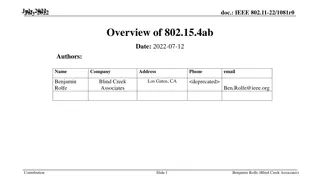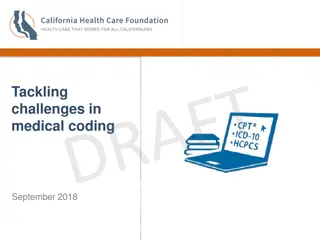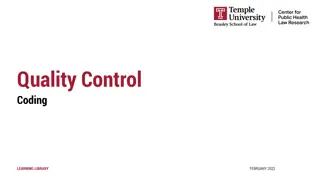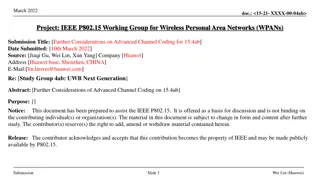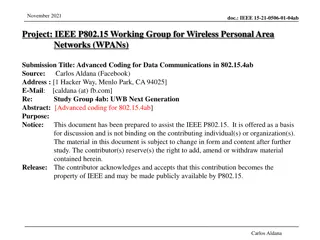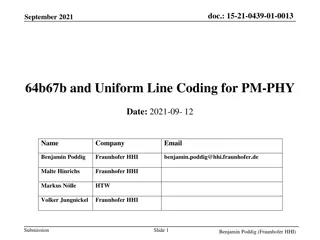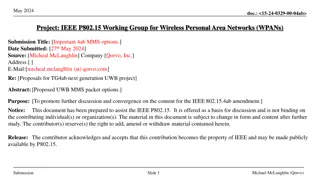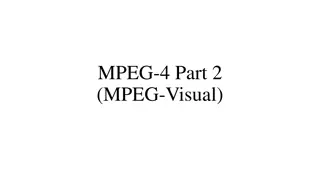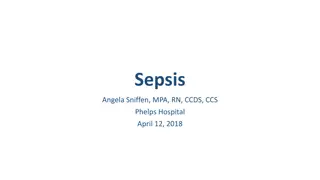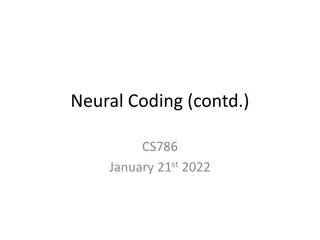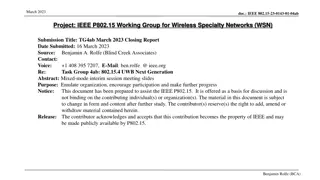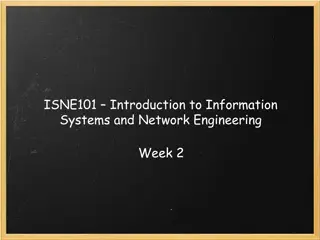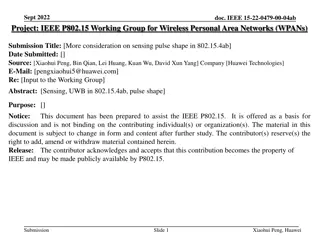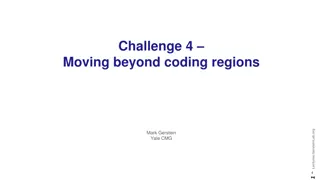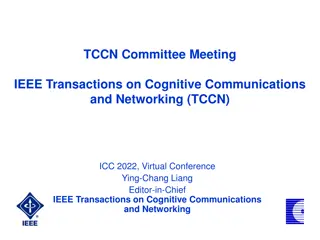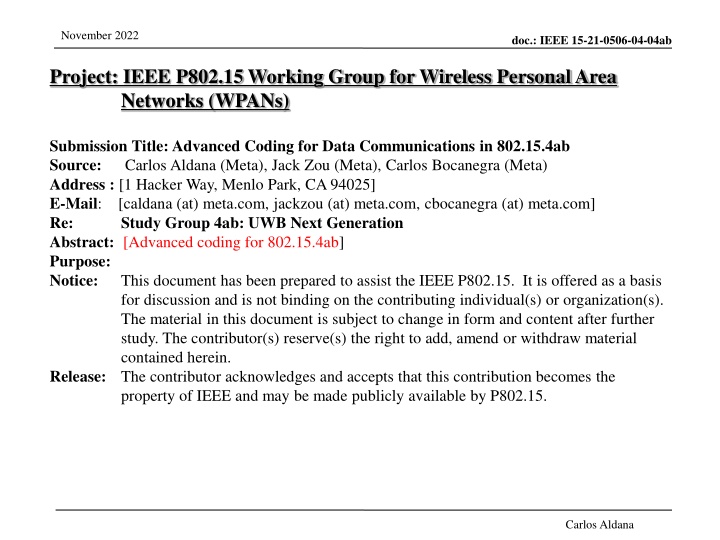
Advanced Coding for Data Communications in 802.15.4ab
This document discusses advanced coding techniques for data communications in the context of IEEE 802.15.4ab, focusing on achieving high throughput, interference mitigation, coexistence improvements, and enhanced link budgets. It explores the need for optional non-BCC coding schemes like LDPC and Turbo codes and the performance of current BCC-based codes. Near Shannon capacity codes such as LDPC, Turbo, and Polar codes are examined for their benefits in reaching close to the Shannon limit. The proposed solutions address issues related to high-density traffic, accuracy, reliability, interoperability, and low latency streaming in wireless personal area networks, emphasizing improved link budgets and compatibility with enhanced ranging capabilities.
Uploaded on | 1 Views
Download Presentation

Please find below an Image/Link to download the presentation.
The content on the website is provided AS IS for your information and personal use only. It may not be sold, licensed, or shared on other websites without obtaining consent from the author. If you encounter any issues during the download, it is possible that the publisher has removed the file from their server.
You are allowed to download the files provided on this website for personal or commercial use, subject to the condition that they are used lawfully. All files are the property of their respective owners.
The content on the website is provided AS IS for your information and personal use only. It may not be sold, licensed, or shared on other websites without obtaining consent from the author.
E N D
Presentation Transcript
November 2022 doc.: IEEE 15-21-0506-04-04ab Project: IEEE P802.15 Working Group for Wireless Personal Area Networks (WPANs) Submission Title: Advanced Coding for Data Communications in 802.15.4ab Source: Carlos Aldana (Meta), Jack Zou (Meta), Carlos Bocanegra (Meta) Address : [1 Hacker Way, Menlo Park, CA 94025] E-Mail: [caldana (at) meta.com, jackzou (at) meta.com, cbocanegra (at) meta.com] Re: Study Group 4ab: UWB Next Generation Abstract: [Advanced coding for 802.15.4ab] Purpose: Notice: This document has been prepared to assist the IEEE P802.15. It is offered as a basis for discussion and is not binding on the contributing individual(s) or organization(s). The material in this document is subject to change in form and content after further study. The contributor(s) reserve(s) the right to add, amend or withdraw material contained herein. Release: The contributor acknowledges and accepts that this contribution becomes the property of IEEE and may be made publicly available by P802.15. Carlos Aldana
November 2022 doc.: IEEE 15-21-0506-04-04ab Technical Guidance [1] PAR Objective Safeguards so that the high throughput data use cases will not cause significant disruption to low duty-cycle ranging use cases. Proposed Solution (how addressed) Interference mitigation techniques to support higher density and higher traffic use cases Other coexistence improvement Backward compatibility with enhanced ranging capable devices (ERDEVs). Improved link budget and/or reduced air-time advanced codes provide improved link budgets Additional channels and operating frequencies Improvements to accuracy / precision / reliability and interoperability for high-integrity ranging; Reduce complexity and power consumption; Hybrid operation with narrowband signaling to assist UWB; Enhanced native discovery and connection setup mechanisms; Sensing capabilities to support presence detection and environment mapping; Low-power low-latency streaming higher data-rate streaming allowing at least 50 Mbit/s of throughput. Support for peer-to-peer, peer-to-multi-peer, and station-to-infrastructure protocols; advanced codes will help enable this use case Infrastructure synchronization mechanisms. Carlos Aldana Slide 2
November 2022 doc.: IEEE 15-21-0506-04-04ab Previous Strawpoll Are you in favor of having an optional non-BCC coding scheme (e.g. LDPC, Turbo) introduced in 802.15.4ab? 21 Y 0 N 3 Abstain Carlos Aldana
November 2022 doc.: IEEE 15-21-0506-04-04ab Background Current codes defined in 802.15.4 and 802.15.4z are based on BCC Below is BCC K=3 and K=7 performance in AWGN channel Shannon placed an upper bound on code rate for a given BW and SNR, or equivalently a minimum SNR for a given code rate and BW. Shannon limit for rate code using BPSK or QPSK (1 bit/dim) is SNR=Eb/No=0dB. For 1% PER, 3e-7 BER, the 802.15.4 code with K=3 is 9.2dB away from Shannon! Carlos Aldana Slide 4
November 2022 doc.: IEEE 15-21-0506-04-04ab Near Shannon Capacity Codes LDPC (Gallagher 1963) [2] shown to reach within 0.0045dB from the Shannon limit [3] amenable to parallelization (better latency) Turbo (Berrou 1993) [4] Polar (Arikan 2008) [5] based on idea of channel polarization Carlos Aldana Slide 5
November 2022 doc.: IEEE 15-21-0506-04-04ab IEEE 802.11n vs Polar codes [6] HW efficiency defined as area per decoded bit 90nm CMOS using standard Dennard scaling laws Area scales as s2 and operating frequency scales as 1/s, where s is the technology feature size Note: BP = belief propagation SC = successive cancellation Note: BP = belief propagation SC = successive cancellation SCL = successive cancellation list SCL = successive cancellation list Polar Decoders are not as HW efficient as LDPC decoders Carlos Aldana
November 2022 doc.: IEEE 15-21-0506-04-04ab Polar vs 3GPP Turbo Results Error floor associated with 3GPP LTE Turbo codes due to some combination of block size and coding rate, rate matching module leads to bad interactions between puncturing and interleaving in the turbo encoder structure . With low Hamming weights, small amounts of channel noise can induce the decoder to make completely wrong decisions, resulting in very high block error rates [7] Becomes worse at higher code rates [8] Y-axis : FER Carlos Aldana
November 2022 doc.: IEEE 15-21-0506-04-04ab Survey of LDPC vs Turbo Decoders Assume power scales as s, where s is the technology feature size ATBF = adaptive threshold bit flipping Improvements in process technology will only reduce these area and power numbers Carlos Aldana Slide 8
November 2022 802.11n LDPC vs 3GPP Turbo doc.: IEEE 15-21-0506-04-04ab 802.11n LDPC Gunnam, Choi (2dB from cap) .09 3GPP Turbo Wong, Lee, Chang (1.5 dB from cap) 0.2 Area (28nm) [mm2] Power (28nm) [mW] 51 68 K,N, rate 972,1944, 1/2 6144, 18432, 1/3 Eb/No operating point (1e-4 PER) SNR (dB) operating point 2dB 0.9 dB 2dB -0.86 dB Carlos Aldana Slide 9
November 2022 doc.: IEEE 15-21-0506-04-04ab Simulation Scenario AWGN channel Floating point sims Soft decisions LDPC (rate ) uses layer belief propagation with offset min-sum approximations with variable number of iterations Turbo (3GPP, rate 1/3) uses max-log-MAP with 8 iterations Polar (3GPP,UL, rate 1/2) uses L=8 list length, nmax = 10 (nmax is upper bound on mother code length) Carlos Aldana Slide 10
November 2022 Performance for different codes doc.: IEEE 15-21-0506-04-04ab Error floor concern for turbo codes, even with floating point simulations Inferior BER performance for Polar codes vs LDPC Carlos Aldana Slide 11
November 2022 Baseline IEEE 802.11n LDPC vs BCC in AWGN doc.: IEEE 15-21-0506-04-04ab Payload (bytes) 40.5 81 121.5 1458 3888 LDPC gain (dB) 1.68 2.18 2.4 2.89 3.07 LDPC gains increase as payload size increases Carlos Aldana Slide 12
November 2022 doc.: IEEE 15-21-0506-04-04ab LDPC on short codewords It is now found there are gains to be had from LDPC even on short data blocks. In fact, the shorter the block length, the larger the gain. 3 802.11n block lengths are considered 648, 1296, 1944 Carlos Aldana Slide 13
November 2022 doc.: IEEE 15-21-0506-04-04ab LDPC 648 on short payload K <= 324 Step 1: Encoder finds parity bits by appending zeros to K information bits K information Bits 324-K zeros 324 parity bits Step 2: Ignore 324-K zeros at TX and send K information bits along with 324 parity bits. Note: Coding rate becomes K/(K+324) K information Bits 324 parity bits Carlos Aldana Slide 14
November 2022 doc.: IEEE 15-21-0506-04-04ab LDPC 1296 on short payload K <= 648 Step 1: Encoder finds parity bits by appending zeros to K information bits K information Bits 648-K zeros 648 parity bits Step 2: Ignore 648-K zeros at TX and send K information bits along with 648 parity bits. Note: Coding rate becomes K/(K+648) K information Bits 648 parity bits Carlos Aldana Slide 15
November 2022 doc.: IEEE 15-21-0506-04-04ab LDPC 1944 on short payload K <= 972 Step 1: Encoder finds parity bits by appending zeros to K information bits K information Bits 972-K zeros 972 parity bits Step 2: Ignore 972-K zeros at TX and send K information bits along with 972 parity bits. Note: Coding rate becomes K/(K+972) Bits 972 parity bits K information Carlos Aldana Slide 16
November 2022 doc.: IEEE 15-21-0506-04-04ab Coding Rate vs Num bytes For rate code, Shannon bound is at 0 dB. For PAM constellations, SNR(dB)>=10log10 (22r -1), where r is the code rate. For rate 1/6 code, Shannon bound is at -5.85 dB. A 5.85 dB improvement is achievable by lowering the code rate below 1/6. This may be possible using the current rate LDPC codes for short payloads. Carlos Aldana Slide 17
November 2022 doc.: IEEE 15-21-0506-04-04ab LDPC decoder The LDPC decoder is trying to determine whether H*cT = 0 The parity bits were acquired assuming that zeros in the data were transmitted. The N/2-K zeros that were ignored at the TX are not ignored at the RX. By setting the LLRs of the zeros to a high value, the certainty of the zeros is shared across multiple equations. Carlos Aldana Slide 18
November 2022 doc.: IEEE 15-21-0506-04-04ab Simulation Assumptions Payload at the PHY level is under consideration 30 LDPC iterations Offset min-sum approx. for LDPC Nsync = 64 preamble symbols using length 91 code NSFD = 8 symbols Sync + SFD duration is 52.5us For BCC, PHR (26 bits) sent at same symbol rate as data For LDPC, PHR (26 bits) sent at symbol rate < data Carlos Aldana Slide 19
November 2022 doc.: IEEE 15-21-0506-04-04ab 100 bytes Packet Duration (us) /Gating gain penalty/Net Gain 2 PHR reps CL7 BCC (us) 1944 LDPC (us) Gating gain penalty (dB) Net gain (dB) 7.8 Mbps 159.9 174.3 0.4 2.4 31.2 Mbps 79.4 82.9 0.3 2.5 62.4 Mbps 65.9 67.7 0.2 2.6 124.8 Mbps 59.2 60.1 0.1 2.7 Without gating gain considerations, LDPC 1944 code gains 2.8 dB over BCC Carlos Aldana Slide 20
November 2022 doc.: IEEE 15-21-0506-04-04ab 40 bytes Packet Duration (us) /Gating gain penalty/Net Gain 3 PHR reps CL7 BCC (us) 1944 LDPC (us) Gating gain penalty (dB) Net gain (dB) 7.8 Mbps 98.4 147.6 1.9 3.2 31.2 Mbps 64.0 76.3 1.3 3.8 62.4 Mbps 58.2 64.4 0.8 4.3 124.8 Mbps 55.4 58.4 0.5 4.6 Without gating gain considerations, LDPC 1944 code gains 5.1 dB over BCC Carlos Aldana Slide 21
November 2022 doc.: IEEE 15-21-0506-04-04ab 30 bytes Packet Duration (us) /Gating gain penalty/Net Gain 3 PHR reps CL7 BCC (us) 1944 LDPC (us) Gating gain penalty (dB) Net gain (dB) 7.8 Mbps 88.1 142.5 2.2 3.7 31.2 Mbps 61.4 75 1.5 4.4 62.4 Mbps 57.0 63.8 0.9 5.0 124.8 Mbps 54.7 58.1 0.5 5.4 Without gating gain considerations, LDPC 1944 code gains 5.9 dB over BCC Carlos Aldana Slide 22
November 2022 doc.: IEEE 15-21-0506-04-04ab How about PHR performance? Carlos Aldana
November 2022 doc.: IEEE 15-21-0506-04-04ab 26 bit PHR performance Num PHR reps SNR (dB) 1% failure rate 1 2.06 2 -0.95 3 -2.7 4 -3.96 Carlos Aldana Slide 24
November 2022 doc.: IEEE 15-21-0506-04-04ab Independent PHR + LDPC results Theoretical minimum payload length (bytes) so that PHR is not limiting PHR rate 648 1296 1944 Note that actual minimum payload lengths are greater than the values listed in this table 0.5 (Num PHR reps =2) 13 32 51 0.33 (Num PHR reps =3) 8 17 27 0.25 (Num PHR reps =4) 5 10 16 Carlos Aldana Slide 25
November 2022 doc.: IEEE 15-21-0506-04-04ab Joint PHR + LDPC Results Carlos Aldana
November 2022 doc.: IEEE 15-21-0506-04-04ab Simulation Assumptions AWGN channel Assume perfect SYNC and SFD detection as well as channel estimation For 7.8 Mbps, Nsync = 64 preamble symbols using length 91 code NSFD = 8 symbols For 1.95 Mbps Nsync = 128 preamble symbols using length 91 code NSFD = 32 symbols Sync + SFD duration is 52.5us Data rate (Mb/s) #chips /symbol SNR_adj (dB) 26 bit PHR from Meta SNR (Symbol)+ Gating gain is included 1.95 256 24.1 7.8 64 18.1 SNR (symbol) = SNR 10*log10(#chips/symbol) 31.2 16 12 = SNR SNR_adj 62.4 8 9 124.8 4 6 Carlos Aldana Slide 27
November 2022 doc.: IEEE 15-21-0506-04-04ab What does performance look like for 7.8 Mbps when PHR reps =2,3, or 4? Carlos Aldana
November 2022 doc.: IEEE 15-21-0506-04-04ab 648 vs 1296 vs 1944 - 2 reps - genie ON (SYNC,SFD) PSDU 5 6 7 8 9 10 11 12 13 14 15 16 17 18 19 20 21 22 23 24 25 26 27 28 29 30 648 1296 -29.0321 -28.921 -29.0298 -28.9756 -28.8802 -28.9038 -28.8538 -29.0148 -28.8193 -28.7922 -28.8643 -28.7157 -28.7651 -28.7334 -28.7834 -28.7525 -28.7151 -28.6482 -28.5989 -28.5828 -28.524 -28.4672 -28.4425 -28.3974 -28.3857 -28.2891 1944 -28.2054 -28.098 -28.2103 -28.1597 -28.0685 -28.0964 -28.0497 -28.2144 -28.023 -27.9987 -28.0783 -27.9317 -27.9825 -27.9539 -28.0067 -27.9806 -27.9463 -27.8825 -27.8701 -27.8514 -27.8737 -27.804 -27.8028 -27.7763 -27.7999 -27.6989 PSDU 31 32 33 34 35 36 37 38 39 40 41 42 43 44 45 46 47 48 49 50 51 52 53 54 55 56 648 1296 -28.2306 -28.2506 -28.1192 -28.0393 -27.9998 -27.9312 -27.863 -27.78 -27.6876 -27.5503 -27.4864 -27.4095 -27.2921 -27.2563 -27.1511 -27.0926 -26.9932 -26.9304 -26.8315 -26.7613 -26.6922 -26.6199 -26.5468 -26.4767 -26.4299 -26.4087 1944 -27.6979 -27.8417 -27.7499 -27.6361 -27.5822 -27.7075 -27.7048 -27.6372 -27.6834 -27.5711 -27.5077 -27.5187 -27.4796 -27.3939 -27.3867 -27.36 -27.3141 -27.2779 -27.261 -27.2326 -27.2127 -27.0821 -27.1052 -27.0022 -26.982 -26.9531 PSDU 57 58 59 60 61 62 63 64 65 66 67 68 69 70 71 72 73 74 75 76 77 78 79 80 648 1296 -26.3681 -26.2905 -26.2258 -26.1503 -26.0902 -26.0303 -26.0079 -25.9436 -25.878 -25.8137 -25.7603 -25.7082 -25.6588 -25.5866 -25.5361 -25.4731 -25.4138 -25.3619 -25.3082 -25.2618 -25.1888 -25.146 -25.1036 -25.0526 1944 -26.8604 -26.8135 -26.7629 -26.7065 -26.6456 -26.6162 -26.5167 -26.4706 -26.4045 -26.3546 -26.3036 -26.2395 -26.1992 -26.1214 -26.1025 -26.0296 -25.9922 -25.916 -25.8245 -25.8048 -25.7292 -25.6957 -25.6502 -25.6076 -30.0543 -29.9372 -30.04 -29.9801 -29.8689 -29.853 -29.6645 -29.5436 -29.2771 -29.1679 -29.1124 -29.0817 -28.9539 -28.8971 -28.6569 -28.519 -28.3298 -28.1704 -27.9459 -27.8556 -27.6674 -27.5495 -27.4198 -27.3886 -27.3199 -27.2356 -27.1352 -27.0452 -26.9616 -26.8044 -26.7632 -26.6746 -26.5858 -26.4828 -26.4176 -26.2886 Through sims, we have found that the best combination is: - 648 CBS when PSDU <= 18 Bytes - 1296 CBS when PSDU in [19,39] Bytes - 1944 CBS when PSDU >= 40 Bytes Carlos Aldana
November 2022 doc.: IEEE 15-21-0506-04-04ab 648 vs 1296 vs 1944 - 3 reps - genie ON (SYNC,SFD) PSDU 5 6 7 8 9 10 11 12 13 14 15 16 17 18 19 20 21 22 23 24 25 26 27 28 29 30 648 1296 -30.5552 -30.5841 -30.52 -30.5087 -30.5118 -30.4943 -30.5113 -30.4323 -30.3089 -30.1916 -30.0435 -29.9474 -29.7672 -29.6405 -29.4609 -29.3992 -29.2316 -29.071 -28.9542 -28.8139 -28.6921 -28.5975 -28.4956 -28.4519 -28.3834 -28.3514 1944 -29.7582 -29.7911 -29.7308 -29.7222 -29.7294 -29.7353 -29.744 -29.7119 -29.6176 -29.5591 -29.5292 -29.6086 -29.6128 -29.6077 -29.5566 -29.4419 -29.4458 -29.3853 -29.2792 -29.2282 -29.0908 -29.0054 -28.9358 -28.8324 -28.7267 -28.6126 PSDU 31 32 33 34 35 36 37 38 39 40 41 42 43 44 45 46 47 48 49 50 51 52 53 54 55 56 648 1296 -28.288 -28.1891 -28.1151 -28.0048 -27.9557 -27.8353 -27.7292 -27.6477 -27.5722 -27.4594 -27.3728 -27.2908 -27.2106 -27.1127 -27.0394 -26.965 -26.8675 -26.82 -26.7109 -26.6567 -26.5638 -26.4957 -26.4225 -26.3352 -26.3047 -26.2289 1944 -28.5186 -28.4152 -28.3243 -28.2435 -28.1196 -28.0544 -27.9246 -27.8494 -27.7472 -27.6399 -27.6133 -27.5497 -27.5248 -27.4952 -27.474 -27.414 -27.3999 -27.3442 -27.3083 -27.232 -27.1968 -27.1357 -27.0471 -26.9958 -26.9528 -26.8762 PSDU 57 58 59 60 61 62 63 64 65 66 67 68 69 70 71 72 73 74 75 76 77 78 79 80 648 1296 -26.21 -26.1594 -26.083 -26.0288 -25.9738 -25.94 -25.8557 -25.7873 -25.7335 -25.6472 -25.6236 -25.57 -25.5 -25.4417 -25.3796 -25.3417 -25.2777 -25.2312 -25.1817 -25.1394 -25.0725 -25.021 -24.9758 -24.9285 1944 -26.8204 -26.7674 -26.6929 -26.6123 -26.5797 -26.4986 -26.4386 -26.3749 -26.3168 -26.2692 -26.1852 -26.1456 -26.1027 -26.0256 -25.9761 -25.9264 -25.8522 -25.7941 -25.7383 -25.726 -25.6404 -25.5967 -25.536 -25.4892 -31.449 -31.246 -31.0341 -30.6937 -30.4053 -30.1006 -29.6762 -29.3983 -29.1839 -29.0496 -28.9788 -28.9368 -28.8364 -28.674 -28.4989 -28.3369 -28.1353 -27.9347 -27.7912 -27.6479 -27.4833 -27.3514 -27.2226 -27.1794 -27.0801 -27.0505 -26.9647 -26.8481 -26.7499 -26.6463 -26.5664 -26.4633 -26.3959 -26.3087 -26.2476 -26.1409 Through sims, we have found that the best combination is: - 648 CBS when PSDU <= 8 Bytes - 1296 CBS when PSDU in [9,18] Bytes - 1944 CBS when PSDU >= 19 Bytes Carlos Aldana
November 2022 doc.: IEEE 15-21-0506-04-04ab 648 vs 1296 vs 1944 - 4 reps - genie ON (SYNC,SFD) PSDU 5 6 7 8 9 10 11 12 13 14 15 16 17 18 19 20 21 22 23 24 25 26 27 28 29 30 648 1296 -31.7006 -31.663 -31.5485 -31.351 -31.1336 -30.9577 -30.7881 -30.5917 -30.4469 -30.2549 -30.0564 -29.8499 -29.6715 -29.5477 -29.394 -29.2377 -29.0932 -28.9548 -28.8101 -28.6615 -28.5399 -28.4396 -28.3367 -28.2526 -28.24 -28.1644 1944 -30.9526 -30.9649 -30.9194 -30.8571 -30.9361 -30.7754 -30.7047 -30.5515 -30.4507 -30.3976 -30.2545 -30.1667 -30.063 -29.9043 -29.8314 -29.6989 -29.5934 -29.4506 -29.3057 -29.2057 -29.0703 -28.9822 -28.8515 -28.7277 -28.6316 -28.5097 PSDU 31 32 33 34 35 36 37 38 39 40 41 42 43 44 45 46 47 48 49 50 51 52 53 54 55 56 648 1296 -28.1276 -28.046 -27.9716 -27.8772 -27.7764 -27.7026 -27.6043 -27.5033 -27.397 -27.2959 -27.2123 -27.1457 -27.0525 -26.9727 -26.9034 -26.8282 -26.7302 -26.6419 -26.5773 -26.4983 -26.44 -26.3595 -26.2661 -26.2091 -26.1784 -26.0976 1944 -28.4292 -28.3247 -28.2047 -28.142 -28.0073 -27.9255 -27.8103 -27.7135 -27.6299 -27.5336 -27.4792 -27.4546 -27.4094 -27.3873 -27.352 -27.2913 -27.256 -27.2176 -27.1713 -27.1343 -27.0878 -26.9821 -26.9342 -26.882 -26.8129 -26.7162 PSDU 57 58 59 60 61 62 63 64 65 66 67 68 69 70 71 72 73 74 75 76 77 78 79 80 648 1296 -26.058 -26.0346 -25.9487 -25.8941 -25.8213 -25.7685 -25.7284 -25.6688 -25.6119 -25.5305 -25.478 -25.4408 -25.3859 -25.3201 -25.2496 -25.212 -25.1746 -25.106 -25.0793 -25.0082 -24.9691 -24.9133 -24.8579 -24.8081 1944 -26.7013 -26.6307 -26.5605 -26.5271 -26.446 -26.3958 -26.3472 -26.2741 -26.1999 -26.1391 -26.082 -26.0189 -25.979 -25.9166 -25.8596 -25.819 -25.7709 -25.7007 -25.6203 -25.5616 -25.5262 -25.4996 -25.4428 -25.3902 -31.6055 -31.2757 -30.9287 -30.5392 -30.1952 -29.9007 -29.5547 -29.2563 -28.9512 -28.8501 -28.7602 -28.7099 -28.6597 -28.463 -28.2749 -28.0864 -27.9667 -27.7452 -27.5889 -27.4319 -27.2929 -27.1533 -27.0155 -26.9791 -26.9732 -26.8386 -26.7791 -26.6704 -26.575 -26.5121 -26.3878 -26.3063 -26.197 -26.0969 -26.0387 -25.9463 Through sims, we have found that the best combination is: - 1296 CBS when PSDU <= 12 Bytes - 1944 CBS when PSDU > 12 Bytes Carlos Aldana
November 2022 doc.: IEEE 15-21-0506-04-04ab Global comparison for 7.8Mbps - genie ON (SYNC,SFD) PSDU 5 6 7 8 9 10 11 12 13 14 15 16 17 18 19 20 21 22 23 24 25 26 27 28 29 30 REPS 4 4 4 4 4 4 4 4 4 4 4 4 4 4 4 4 4 4 4 3 3 3 3 3 3 3 CBS 1296 1296 1296 1296 1296 1296 1296 1296 1944 1944 1944 1944 1944 1944 1944 1944 1944 1944 1944 1944 1944 1944 1944 1944 1944 1944 SNR @ 1% -31.7006 -31.663 -31.5485 -31.351 -31.1336 -30.9577 -30.7881 -30.5917 -30.4507 -30.3976 -30.2545 -30.1667 -30.063 -29.9043 -29.8314 -29.6989 -29.5934 -29.4506 -29.3057 -29.2282 -29.0908 -29.0054 -28.9358 -28.8324 -28.7267 -28.6126 PSDU 31 32 33 34 35 36 37 38 39 40 41 42 43 44 45 46 47 48 49 50 51 52 53 54 55 56 REPS 3 3 3 3 3 3 3 3 3 3 3 3 3 3 3 3 3 3 3 2 2 3 2 2 2 2 CBS 1944 1944 1944 1944 1944 1944 1944 1944 1944 1944 1944 1944 1944 1944 1944 1944 1944 1944 1944 1944 1944 1944 1944 1944 1944 1944 SNR @ 1% -28.5186 -28.4152 -28.3243 -28.2435 -28.1196 -28.0544 -27.9246 -27.8494 -27.7472 -27.6399 -27.6133 -27.5497 -27.5248 -27.4952 -27.474 -27.414 -27.3999 -27.3442 -27.3083 -27.2326 -27.2127 -27.1357 -27.1052 -27.0022 -26.982 -26.9531 PSDU 57 58 59 60 61 62 63 64 65 66 67 68 69 70 71 72 73 74 75 76 77 78 79 80 57 REPS 2 2 2 2 2 2 2 2 2 2 2 2 2 2 2 2 2 2 2 2 2 2 2 2 2 CBS 1944 1944 1944 1944 1944 1944 1944 1944 1944 1944 1944 1944 1944 1944 1944 1944 1944 1944 1944 1944 1944 1944 1944 1944 1944 SNR @ 1% -26.8604 -26.8135 -26.7629 -26.7065 -26.6456 -26.6162 -26.5167 -26.4706 -26.4045 -26.3546 -26.3036 -26.2395 -26.1992 -26.1214 -26.1025 -26.0296 -25.9922 -25.916 -25.8245 -25.8048 -25.7292 -25.6957 -25.6502 -25.6076 -26.8604 Allowing for variable number of PHR repetitions, the results suggest that we should use LDPC 1296 for 12 bytes or less and 1944 for 13 bytes or more. Carlos Aldana
November 2022 doc.: IEEE 15-21-0506-04-04ab Global comparison for 7.8Mbps - genie ON (SYNC,SFD) The plot above shows ~1dB performance benefit of using either 3 or 4 PHR reps for smaller PSDU sizes while incurring minimal loss for the larger PSDU sizes. Carlos Aldana
November 2022 doc.: IEEE 15-21-0506-04-04ab What does performance look like for 1.95 Mbps when PHR reps =2? Carlos Aldana
November 2022 doc.: IEEE 15-21-0506-04-04ab 648 vs 1296 vs 1944 - 2 reps - genie ON (SYNC,SFD) PSDU 5 6 7 8 9 10 11 12 13 14 15 16 17 18 19 20 21 22 23 24 25 26 27 28 29 30 648 1296 -29.9808 -30.0328 -29.9765 -29.8886 -30.0569 -29.9667 -29.7687 -29.8243 -29.8269 -29.8102 -29.7685 -29.7469 -29.5952 -29.7229 -29.6373 -29.6248 -29.5625 -29.5775 -29.5798 -29.5344 -29.4367 -29.3702 -29.3515 -29.2946 -29.2262 -29.2065 1944 -28.9555 -29.0164 -28.9662 -28.8844 -29.0599 -28.9734 -28.7816 -28.8427 -28.8503 -28.839 -28.8026 -28.7863 -28.6404 -28.7727 -28.6931 -28.6848 -28.6281 -28.661 -28.6932 -28.6586 -28.5522 -28.5736 -28.6194 -28.5665 -28.4447 -28.4981 PSDU 31 32 33 34 35 36 37 38 39 40 41 42 43 44 45 46 47 48 49 50 51 52 53 54 55 56 648 1296 -29.1253 -29.0449 -29.0216 -28.9715 -28.8402 -28.7864 -28.6822 -28.606 -28.5216 -28.4165 -28.3447 -28.2681 -28.1638 -28.057 -27.9808 -27.8925 -27.829 -27.7224 -27.6546 -27.5756 -27.5407 -27.4309 -27.3692 -27.2842 -27.2443 -27.1751 1944 -28.3884 -28.4314 -28.4432 -28.5772 -28.3177 -28.3438 -28.286 -28.3366 -28.3027 -28.2005 -28.2392 -28.2282 -28.1679 -28.0822 -28.0378 -28.0697 -28.0184 -27.9689 -27.961 -27.9006 -27.8506 -27.8046 -27.7923 -27.6891 -27.6535 -27.5685 PSDU 57 58 59 60 61 62 63 64 65 66 67 68 69 70 71 72 73 74 75 76 77 78 79 80 81 648 1296 -27.133 -27.0616 -27.0352 -26.9416 -26.869 -26.8043 -26.7734 -26.6883 -26.5858 -26.5657 -26.4855 -26.4321 -26.3898 -26.3312 -26.2636 -26.2092 -26.1571 -26.0937 -26.0457 -25.9852 -25.9232 -25.8832 -25.8143 -25.7605 -25.7293 1944 -27.5214 -27.4806 -27.4159 -27.3668 -27.2873 -27.2295 -27.1916 -27.1216 -27.0594 -26.9905 -26.9371 -26.8599 -26.8253 -26.7494 -26.7085 -26.6375 -26.5992 -26.5404 -26.4906 -26.4425 -26.3565 -26.3019 -26.2588 -26.2156 -26.1509 -31.3199 -31.3613 -31.2956 -31.2003 -31.3299 -31.1562 -30.8881 -30.7426 -30.5777 -30.4156 -30.316 -30.2857 -30.1965 -30.0553 -29.8277 -29.7208 -29.5337 -29.3439 -29.1158 -28.9721 -28.8343 -28.7049 -28.5645 -28.5067 -28.4366 -28.3406 -28.2555 -28.1513 -28.0344 -27.946 -27.8417 -27.7533 -27.652 -27.5319 -27.4455 -27.4046 Through sims, we have found that the best combination is: - 648 CBS when PSDU <= 20 Bytes - 1296 CBS when PSDU in [21,42] Bytes - 1944 CBS when PSDU >= 43 Bytes Carlos Aldana
November 2022 doc.: IEEE 15-21-0506-04-04ab Conclusions LDPC was successfully introduced in 802.11n [12] and 5G NR as well as other standard bodies (e.g., 802.15.3c, 802.11ad/ay, 802.16e, 802.3an, and DVB-S2) and is a mature technology that should be considered in IEEE 802.15.4ab LDPC provides substantial coding gains for both long and short payloads For short payloads, LDPC gains improve with higher data rates LDPC decoder could have both small area and low power in <=28nm CMOS For 7.8 Mbps and above, 3 or 4 PHR repetitions should be used and LDPC 1296 should be used for 12 bytes or less and LDPC 1944 for 13 bytes or more. For 1.95 Mbps with 2 PHR repetitions, LDPC 648 should be used for 20 bytes or less, 1296 for payloads between 21 and 42 bytes, and 1944 for payloads greater than or equal to 43 bytes. Carlos Aldana
November 2022 doc.: IEEE 15-21-0506-04-04ab References [1] 15-21-297-01 15.4.ab Technical Guidance Doc [2] R.G. Gallagher, Low-Density Parity-Check Codes . Cambridge, MA : MIT Press, 1963. [3] Chung, et al, On the design of low-density parity-check codes within 0.0045dB of the Shannon limit , IEEE Commun. Letters, vol. 5, no.2, pp.58-60, February 2001. [4] Berrou, et al, Near Shannon Limit Error Correcting coding and decoding : Turbo Codes , Proceedings of ICC 93 IEEE International Conference on Communications [5] Arikan, A performance comparison of polar codes and Reed-Muller codes , IEEE Communications Letters, 2008, vol. 12, issue 6. [6] Balatsoukas-Stimming, Giard, Burg, Comparison of Polar Decoders with Existing Low-Density Parity-Check and Turbo Decoders , 2017 IEEE WCNC [7] J.-F. Cheng, A. Nimbalker, Y. Blankenship, B. Classon, and T. Blankenship, Analysis of circular buffer rate matching for LTE turbo code, in Proc. IEEE 68th Vehicular Technology Conference (VTC 2008-Fall), Calgary, Canada, Sept. 2008. [8] 3GPP R1-164359 [9] Chen, Dholakia, Eleftheriou, Fossorier, Hu, Reduced-complexity decoding of LDPC codes , IEEE Trans. On Communications, vol 53, pp. 1288-1299, Aug 2005. [10] Hui, Sandberg, Blankenship, Andersson, Grosjean, Channel Coding in 5G New Radio: A Tutorial Overview and Performance Comparison with 4G LTE , in IEEE Vehicular Technology Magazine, vol. 13, Issue #4. [11] 3GPP R1-1610600 [12] IEEE 802.11 Wireless LANs WWiSE Proposal: High Throughput Extension to the 802.11 Standard, IEEE 11-04-0886-06-000n, 2005 Carlos Aldana
November 2022 doc.: IEEE 15-21-0506-04-04ab Appendix Carlos Aldana
November 2022 Early Stopping criterion for LDPC Kienle, Wehn Low complexity stopping criterion for LDPC code decoders ,VTC 05 Li, You, Early stopping for LDPC decoding: convergence of mean magnitude (CMM) 2006 Cui, Chen An efficient early stopping scheme for LDPC decoding , 2007 Shin, et al., A Stopping Criterion for LDPC , VTC 07 Chen, et al., A Channel-Adaptive Early Termination Strategy for LDPC Decoders , 2009 doc.: IEEE 15-21-0506-04-04ab Carlos Aldana Slide 39


